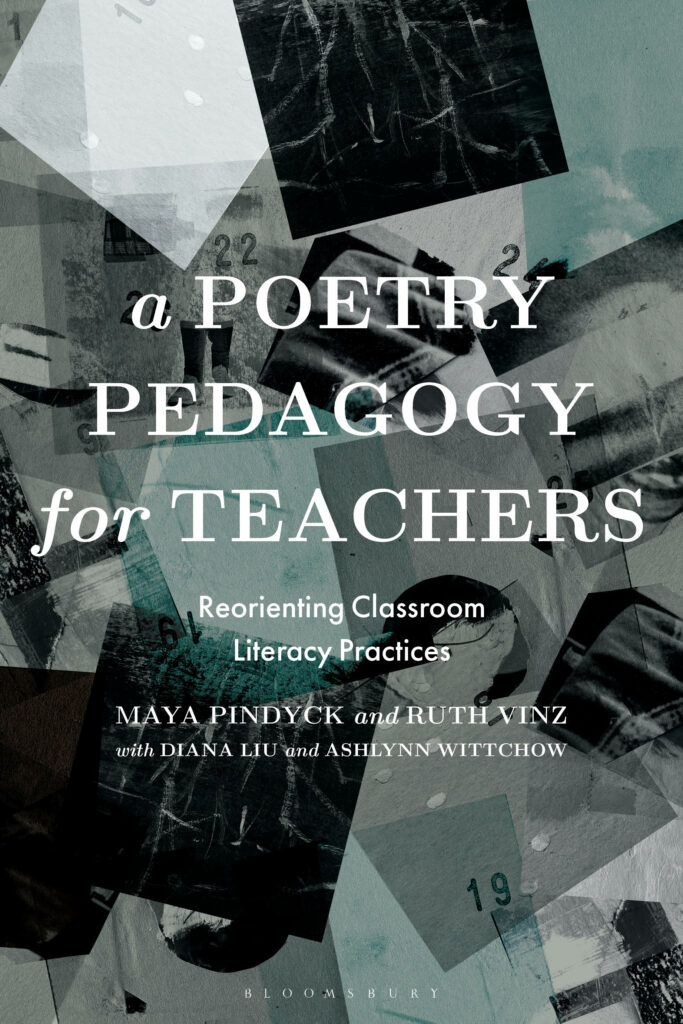Also in the magazine: “Let the Poem Do the Teaching,” an excerpt from A Poetry Pedagogy for Teachers: Reorienting Classroom Literary Practices by Maya Pindyck and Ruth Vinz.
The first time I met Ruth Vinz, sometime in late February or early March of 1993, she walked me to the subway. It was early evening, cold and dark. As a native New Yorker, I was surprised. This woman from Idaho was worried about me getting back to the subway? But I would have lingered for hours in conversation at the corner of 120th and Broadway. Her words came like molasses out of a jar, slowly but fluidly, unlike everything and everyone rushing by us, distinct from my own fast talking and arms waving. But I had to meet my train at Penn Station.
I’d recently been accepted into Columbia’s MA program in English Education, and Ruth was the chair. After working in the U.S. House of Representatives immediately after college, I was going to become a public school teacher. I’d come to spend the afternoon at Teachers College, meet with Ruth, and make a decision. At the time, I believed I knew far more than I did. I went to school, so I know how schools work, right? And I came from a family full of teachers—my mother, my aunts, and my grandmother were all educators who got their start in New York City.
The specifics of the conversation now elude me, but what I do remember is how Ruth listened to what I had to say. As she did so, I felt myself beginning to change. She talked to me like a colleague, like I was already a teacher instead of a person with the idea of being a teacher. Walking down the steps to the subway, I knew I’d never heard someone talk about the classroom the way she did. I wanted to hear her voice again—its aurality as well as its weight.
Developing our teaching philosophy was a continual process of interrogation, week after week. It was a fertile field to be turned over and over again in the years ahead.
In fall of 1994, I was a student in Ruth’s course “The Teaching of Reading Literature.” While the focus was on reading, writing was a part of every conversation, every activity. We wrote to think, we wrote before reading, we wrote after. We read like writers. We interrogated our identities as readers to consider the reading identities of our students. All of us were in middle or high school classrooms for a portion of each week, and Ruth challenged us to examine and negotiate the dynamics of those classrooms in the context of our personal expectations and our new understandings of literacy learning. She asked us a lot of questions and created the conditions for us to come up with the beginnings of answers. Of course, the real answers are not to be found. They evolve over the course of our careers.
Our identities and experiences were as central to the course as the texts we read. Across a string of Tuesday evenings, Ruth set the stage for us to translate our reading identities into teaching philosophies—our frameworks for classroom planning. But this was not some box to check off. Developing our teaching philosophy was a continual process of interrogation, week after week. It was a fertile field to be turned over and over again in the years ahead. She started not with written texts but living texts: our own identities and those of our students.
As I look at my first paper for the course, I still recognize myself in the person who wrote the paper:
If we can’t teach our students to value their own experiences, their own first reactions, their own choices of books, what’s the point of trying to discuss character development and theme? Why do we teach literature in our classroom? Is it so that students can grow up, leave our classroom and never see those intangible themes in their lives? Or do we want them to learn to at least value and enjoy, if not love books for how they can speak to our personal and communal life experiences? Do we want them to think that a book only represents the meaning that we see, or do we want to challenge them to take it apart and put it together in a way that creates meaning for them?
But I also see myself in Ruth’s marginal comments directed back to me: “Yes, but how will we do this? What are the issues and how do we get at them?” Towards the end of the paper, she writes: “Yes . . . but the issues are overwhelming. How do we choose? Meet all interests? Get people involved without leading? It’s huge.”
In her voice, I now hear my own, and the ways in which I have responded to my students over the years—first middle schoolers, then high schoolers, middle schoolers again, now graduate students. Responding to students is an ongoing conversation within and outside of any single assignment. It’s connecting, probing, affirming, and wondering about the big ideas at work as well as the particulars of the task. Ruth modeled that for me from the very beginning.
So much of teaching and learning is specific and context-dependent: the culture of the school we’re in, the composition of the students in a class and the cultures, passions, interests, and traumas they bring. But what I learned from Ruth in that very first semester of working with her, what has stuck with me all these years later, is the simplicity within the complexity. Center students’ voices. Listen to them. Give them multiple ways to return to a text, to reconsider a text, to read texts in the context of other texts. Trust the power of conversation, while making sure you have plans to guide it.

There is a cacophony of voices chiming in on literacy education in the United States. There are concerted efforts to keep books away from students, to deny students the opportunity to read about the world around them, about the experiences of others similar to and different from themselves. The COVID-19 pandemic pushed so many course materials, from elementary school to college, online. There are programs that promise to meet the needs of all learners if done “with fidelity.” Taking time for discussions feels like an impossible luxury. It’s a lot. It’s easy to get overwhelmed.
In one of my other classes that first year at Teachers College, Professor Maxine Green told us that if we teach, we have to ask ourselves, “What right do we have to interfere in the lives of others?” I’ve held onto that question. It always percolates just below the surface.
All these years later, now as a teacher educator myself, I hear Ruth when designing a syllabus, when planning a class. I start with the big picture. A distillation, not a bag of tricks. A landscape to paint, not merely a list of outcomes. What do I want my students to explore and grapple with? Why am I asking them to spend time with these texts? How am I positioning both students and texts? What do I hope they will learn from this set of experiences and what will they teach me in turn?
What I learned from Ruth in that very first semester of working with her, what has stuck with me all these years later, is the simplicity within the complexity.
During one particular class meeting back in 1994, Ruth discussed Mentor from “The Odyssey,” an elderly man in whom Odysseus places the care of the kingdom when he leaves for Troy. Athena, taking the form of Mentor, encourages Telemachus to seek out the missing Odysseus and accompanies him on that journey. I don’t exactly remember what Ruth said about Mentor. But forever after, I connect Mentor and Ruth. Athena, Ruth. The wise, trusted guide.
In November of 2022, when the National Council of Teachers of English held its first in-person convention post-COVID, Ruth and one of my former students were presenting concurrently on opposite sides of the convention center. After listening to my former student, I left halfway through the session and raced down the convention corridors to find Ruth—to again hear her voice. And when I did, a little out of breath, but immersed in the moment, tucked into the comfortable context of Ruth’s teaching, I was reminded anew that teaching is mentoring.
While presenting during my own session the next day, with Ruth at one table, my former student at another, I found myself saying, unplanned, “In this room, we are all mentors and mentees.”
We are all readers and writers in mutual mentorship. Our conversations never really end.
Also in the Magazine:
“Let the Poem Do the Teaching,” an excerpt from A Poetry Pedagogy for Teachers by Maya Pindyck and Ruth Vinz.
“Reorienting Classroom Literacy Practices: A Conversation with Maya Pindyck” by Susan Karwoska

Mary Ann Cappiello
Mary Ann Cappiello is a Professor of Language and Literacy at Lesley University in Cambridge, Massachusetts, where she teaches courses in children's and young adult literature and literacy methods, including a specialized course in nonfiction for children and young adults. She is the co-author of Reading with Purpose: Selecting and Using Children’s Literature for Inquiry and Engagement, Text Sets in Action: Pathways Through Content Area Literacy, and other professional books for teachers, and the author of the historical essay “Searching for Dinah Tuck.” She is a founding member of The Biography Clearinghouse and cochaired the writing of NCTE’s 2023 Position Statement on the Role of Nonfiction Literature K-12. Previously, she blogged about children's and young adult literature at "The Classroom Bookshelf," a School Library Journal blog, and chaired NCTE’s Orbis Pictus Award for Outstanding Nonfiction (K-8) Committee.



